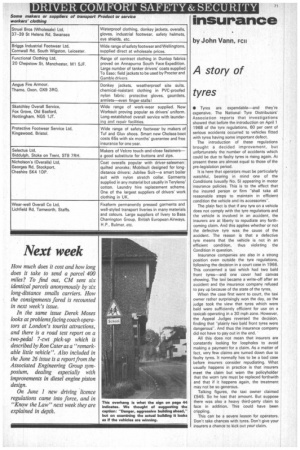A story of
Page 71

If you've noticed an error in this article please click here to report it so we can fix it.
tyres
• Tyres are expendable—and they're expensive. The National Tyre Distributors' Association reports that investigations showed that before the introduction on April 1 1968 of the tyre regulations, 60 per cent of serious accidents occurred to vehicles fitted with tyres having some important defect.
The introduction of these regulations brought a decided improvement, but unfortunately the number of accidents which could be due to faulty tyres is rising again. At present these are almost equal to those of the pre-legislation period.
It is here that operators must be particularly watchful, bearing in mind one of the Conditions (usually No. 5) appearing in motor insurance policies. This is to the effect that the insured person or firm "shall take all reasonable steps to maintain in efficient condition the vehicle and its accessories".
The plain fact is that if any tyre on a vehicle does not comply with the tyre regulation's and the vehicle is involved in an accident, the insurers are at liberty to repudiate any forthcoming claim. And this applies whether or not the defective tyre was the cause of the accident. The reason is that a defective tyre means that the vehicle is not in an efficient condition, thus violating the Condition in question. •
Insurance companies are also in a strong position even outside the tyre regulations, following the decision in a court case in 1966. This concerned a taxi which had two bald front tyres—and one cover had canvas showing. The taxi became a write-off after an accident and the insurance company refused to pay up because of the state of the tyres.
When the case first went to court, the taxi owner rather surprisingly won the day, as the judge took the view that tyres which were bald were sufficiently efficient for use on a taxicab operating in a 30 mph zone. However, the Appeal Judges reversed the decision, finding that "plainly two bald front tyres were dangerous". And thus the insurance company did not have to pay out in the end. '
All this does not mean that insurers are constantly looking for loopholes to avoid making a payment for a claim. As a matter of fact, very few claims are turned down due to faulty tyres. It normally has to be a bad case before insurers consider repudiating. What usually happens in practice is that insurers meet the claim but warn the policyholder that the worn tyre must be replaced forthwith and that if it happens again, the treatment may not be so generous.
Talking figures, the taxi owner claimed £545. So he lost that amount. But suppose there was also a heavy third-party claim to face in addition. This could have been copping.
This can be a severe lesson for operators. Don't take chances with tyres. Don't give your insurers a chance to kick out your claim.


























































































































